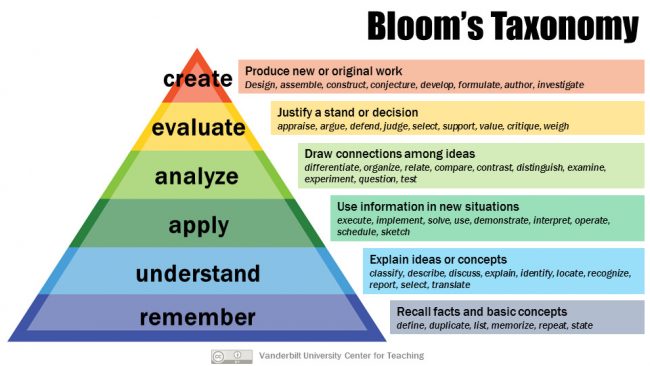Discussions in Canvas – Asking Good Questions – Part 1
By Roberta Campbell-Chudoba
Asking questions is one of the most powerful tools we have as instructors. Just like asking good questions in class, promoting discussion with questions that capture students’ attention and stimulate intellectual engagement can be facilitated online, using Canvas Discussions.
Crafting questions for a discussion forum depends on the purpose of the discussion, and your learning outcomes. Open-ended questions with multiple possible responses challenge students and can help to deepen the discussion, supported by your facilitation (or your TA’s) in the forum.
One way to create open-ended questions with multiple possible responses is by using Bloom’s hierarchy (1956; Anderson & Krathwohl, 2000) of cognitive skills, a framework that asserts higher-level cognitive skills are dependent on a strong foundation of remembering and understanding. Refer back to your learning outcomes to determine what level of questions you need to ask.

Higher-order questions challenge students to expand their critical thinking skills by asking them to analyze, synthesize, evaluate, and/or create. In a discussion board, we can ask questions to gauge students’ comprehension, and then extend their thinking to re-examine or apply what they are learning.
For example, questions about a problem or case study can require students to explain the problem or scenario and apply what they have learned previously to a new task. The purpose of the discussion leads us to the type of question we need to pose.
Asking “Why?” and “How?” is often more beneficial than asking “What?” in both face-to-face teaching and discussion forums. Using the example verbs in the diagram above can help to frame questions for the cognitive task for which you are aiming. For a more extensive list, see: Bloom’s Taxonomy of Action Verbs.
Questions to prompt and encourage engagement
After setting discussion forum norms or etiquette with students, and once the discussion underway, you might:
- Ask students to clarify comments or responses (sometime even when the comment makes sense to you, as this can be helpful for other students in the class). “Are you saying that…?” “Could you give me an example of?”
- Ask questions to probe students’ assumptions – of which they be unaware, until asked to articulate them. “What are you assuming here?” “What could we assume instead?” “Is this always the case?”
- Ask questions that probe reasons, evidence, and causes to lead students to support their arguments. “What are your reasons for saying that?” “What other information do we need to know?” “Is there good evidence for believing that?” “What do you think the cause is?”
- Ask questions that probe implications and consequences. “When you say___, are you implying that____?” “If you do that, what will happen?” “How is that connected to the question?” “How does that bear on ____?”
- Ask questions that help students recognize and clarify their own thought processes. “Could you express that point in another way?” “Could you be more specific?” “Have you thought of…?” “What factors make this a difficult problem?” “What would this look like from the point of view of ___?”
- Ask questions that require students to defend their positions. Playing ‘devil’s advocate,’ can benefit other students in the forum to consider opposing opinions and approaches.
- Make note of the goals achieved as the discussion progresses with a summary statement in the forum – or ask a student to provide a summary. Pointing out what has been learned or discovered can sustain a sense of purpose and spirited inquiry to look toward the next discussion.
Questions to prompt and encourage, above, used with permission from McGraw Center for Teaching and Learning, Princeton University.
Going forward:
-
- Encourage your TAs to use the prompting and guiding questions to facilitate online discussions
- Keep track of questions that worked well in Discussion Forums from term to term. For those outstanding responses, ask students’ permission to use their post as exemplars, either anonymously or with name attached
- Critique your questioning skills from time to time, either in the planning stage or post-lesson or unit. See pages 5 and 6 of Developing Questioning Skills for ideas.
Sources
Anderson, L. W., & Krathwohl, D. R. (Eds.). (2000). A taxonomy for learning, teaching, and assessing : A revision of Bloom’s taxonomy of educational objectives. New York, NY : Pearson.
Bloom, B., Englehart, M., Furst, E., Hill, W., & Krathwohl, D. (1956) Taxonomy of educational objectives: The classification of educational goals. Handbook I: Cognitive domain. New York, NY: Longmans, Green & Co.
Bloom’s Taxonomy diagram is licensed by Vanderbilt University under the Creative Commons Attribution 4.0 International License. To view a copy of the license, visit Creative Commons Licenses by 4.0.